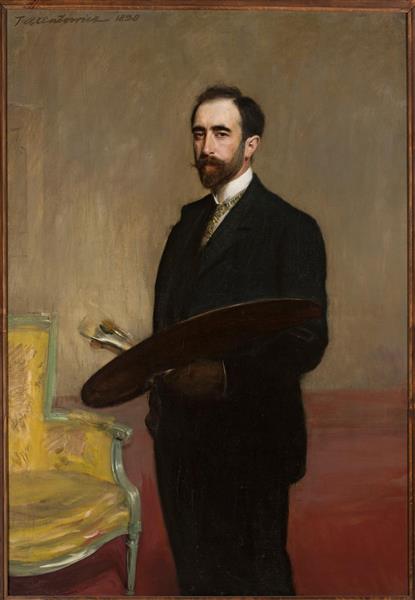Descrizione
The painting “Self-Portrait with a Palette” from 1898 by the talented Polish artist Teodor Axentowicz offers a fascinating window into the psychological and aesthetic world of its creator, capturing not only his image, but also his essence as a painter. This self-portrait is a testament to the technical skill and distinctive style that Axentowicz cultivated throughout his career, reflecting both his influence from European Symbolism and his connection to Realism.
Looking at the canvas, the viewer is greeted by the imposing figure of the artist, presented in a resolute foreground. The choice of self-portrait as a means of expression is significant; it is a common practice in art history, but in this case, Axentowicz seems to seek not only the physical representation of his person, but also an introspective exploration that invites the audience to contemplate the creative process. With a palette in his right hand, his gesture suggests an act in progress, the author himself being a process in progress.
The artistic composition is carefully balanced, highlighting the figure of the painter in the centre, making him the main focus of the work. Axentowicz uses light and shadow masterfully, creating an almost theatrical atmosphere that highlights the facial features and the expression of his gaze. His expression is enigmatic, prompting the viewer to interpret the emotions behind his deep gaze. The contrasts between light and shadow add a dimension of drama, bringing a sense of volume and three-dimensionality to the work.
In terms of colour, Axentowicz adopts a rich and varied palette, which oscillates between darker tones and subtle warm nuances. The artist’s skin, illuminated in such a way that it seems almost glowing, contrasts with the background that blurs into a range of more muted tones, helping to integrate the viewer into the painter’s personal universe. The choice of colours not only serves to highlight the subject, but can also be interpreted as a representation of his inner world and emotional state.
It is interesting to note how the use of the palette also acts as a symbol of artistic struggle and the search for authenticity. The palette becomes a metaphor for the artistic process: the act of mixing colours, of creating and transforming reality through one’s unique vision. This duality between the artist and his work is palpable in this work, where Axentowicz not only portrays himself, but also positions himself as the channel through which his creativity is expressed.
Teodor Axentowicz was a leading exponent of 19th-century Polish art, known for his mastery of portraiture and his ability to fuse symbolism with realism. His training in various art schools in Italy and his influence by Renaissance masters are clearly felt in his approach to form and color, as well as his ability to capture not only the appearance, but also the psyche of his subjects. Self-Portrait with Palette serves as a shining example of this style, showcasing his ability to transcend simple representation in favor of deeper, more personal exploration.
This painting, although it may not be as widely recognised as other masterpieces of its time, deserves a prominent place in the narrative of 19th-century Polish and European art. In it, Axentowicz achieves what every artist aspires to: to be both the reflection and the creator of his own image, establishing a continuous dialogue between art, artist and viewer – a theme that remains as relevant today as it was at the time of its creation.
KUADROS ©, a famous painting on your wall.
Hand-made oil painting reproductions, with the quality of professional artists and the distinctive seal of KUADROS ©.
Painting reproduction service with satisfaction guarantee. If you are not completely satisfied with the replica of your painting, we will refund 100% of your money.

